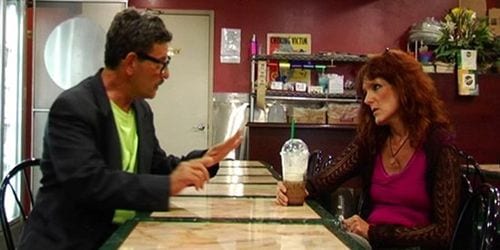
I don’t think there’s anything wrong with it being nonlinear.
— Robert Feingold
“How would you like to see footage of yourself when you were 19 years old and realize that you had something you never thought you had?” Watching such footage, Ruby Lynn Reyner isn’t so much sad or even nostalgic as she is pleased. Resurrected from a “chicken coop in California,” the film she acted in back in 1970 is now flickering on a laptop monitor. And as rough and un-assembled as that footage may be, she smiles when she sees it. “I was beautiful,” she says.
Reyner’s the main reason that footage is now available to the rest of us, in the refitted form of Finishing Heaven. The documentary, which premiered on HBO2 30 September and will air throughout October, follows her efforts to get the film, called Heaven, finished. It’s not her film, precisely, though she does argue for writing credit with her ex-lover and ex-director, Robert Feingold. It’s his project, shot on 16mm in New York City, featuring Andy Warhol players and sort of initially produced by his film teacher at the time, Martin Scorsese.
Feinberg has fond memories of his mentor, who makes a brief appearance near the end of the documentary, receiving his 2006 Oscar for The Departed. Watching the TV screen, Feingold may be genuinely moved (“Good for Marty”), or he may be feeling that this long-time-coming achievement is yet one more reason for him to complete his own film. Watching pieces of his film, he’s most impressed by what you don’t see. “I was in control of the situation,” he says. “I don’t know what situation I was in control of, but I was totally in control.” Finishing Heaven is less concerned with explaining or even understanding Feingold than it is in seeing him as a kind of symptom — of the era he remembers so fondly, its ambition and ambivalence. His relationship with Ruby is key to that portrait: they argue repeatedly and repetitively, revisiting old passions, remembering why they were together and why they split up. Heaven — unfinished and unresolved — shapes and reflects the relationship, at once a metaphor and a stack of film cans.
“Half of him, maybe 40% of him, wants to finish it. Sixty percent of him can’t. I don’t think it’s like he knows that he can’t finish it. He doesn’t know. He’s just floundering around,” Reyner says, her face close to the camera. “When we were together, I saw in him that he was going to be famous. He was going to be incredible.” As Mark Mann’s documentary shows, her vision of Feingold was a function of his own. “I was really a boy wonder,” he recalls. Now, he stands on a rooftop, the camera circling him. “When I was 22, it was great to have a film. When you’re 58 and you have a film you still haven’t finished, that’s not so great already.” His belief in his greatness seems one motivation for Feinberg to agree to the documentary: a title card indicates that in return for his participation, the producers agree to transfer the film to digital format, so the director can edit on his Mac (helped by editor Connor Kalista, who appears repeatedly seated before a rudimentary editing bay, looking variously bemused and weirded out by Feinberg).
Reyner describes the symptom he embodies somewhat differently: “He can’t finish something because, then what? He couldn’t be a victim. He’d have to live his life like anybody else.” He plays this part consistently, taking Mann’s crew along for a visit to his childhood home in the snowy Catskills (“What I remember, what they were saying about me is, ‘You’re a creep, you’re a creep. ‘That was my family saying that”), including a stop at his mother’s grave (things with her were left “unresolved,” he confesses, then spends some minutes leaning on the headstone while he complains he was not informed about her lengthy illness. “I’m trying to be honest,” he sighs. “Is that being shallow? Maybe I just am shallow. Who’s more shallow, somebody who’s making a film about a shallow person or a shallow person?”
Mann and crew don’t take this bait (unless you count the inclusion of the scene in their movie). But Finishing Heaven does give Feinberg enough rope to dangle his own self-image — as lifelong rebel, precocious artist, and misunderstood genius. Urging Kalista to appreciate the fragmentation of Heaven, he also worries over what he’s lost. “I think the most painful part of the editing process,” he says, “is looking at the material and seeing all the things you should have done that you haven’t done. Things that would have been really easy to do if you had just thought of it before.”
“If only” is a sentiment laced throughout Finishing Heaven, in the outsized, sometimes touching and sometimes silly performances by both Reyner and Feinberg. (“Ruby Lynn was this kind of epic figure who would sweep in from time to time to make my life magical,” recalls her brother Andrew.) Their delirious past life — five-some years of New York coolness, sex and drugs and much-publicized promise — is evoked in news photos as well as bits of Reyner from Heaven, blowing soap bubbles in a bathtub or scampering naked up a red-carpeted staircase. If they’re not so iconic as they once imagined, they expose, in spite of themselves, the art of unfinished business.

![Call for Papers: All Things Reconsidered [MUSIC] May-August 2024](https://www.popmatters.com/wp-content/uploads/2024/04/all-things-reconsidered-call-music-may-2024-720x380.jpg)



